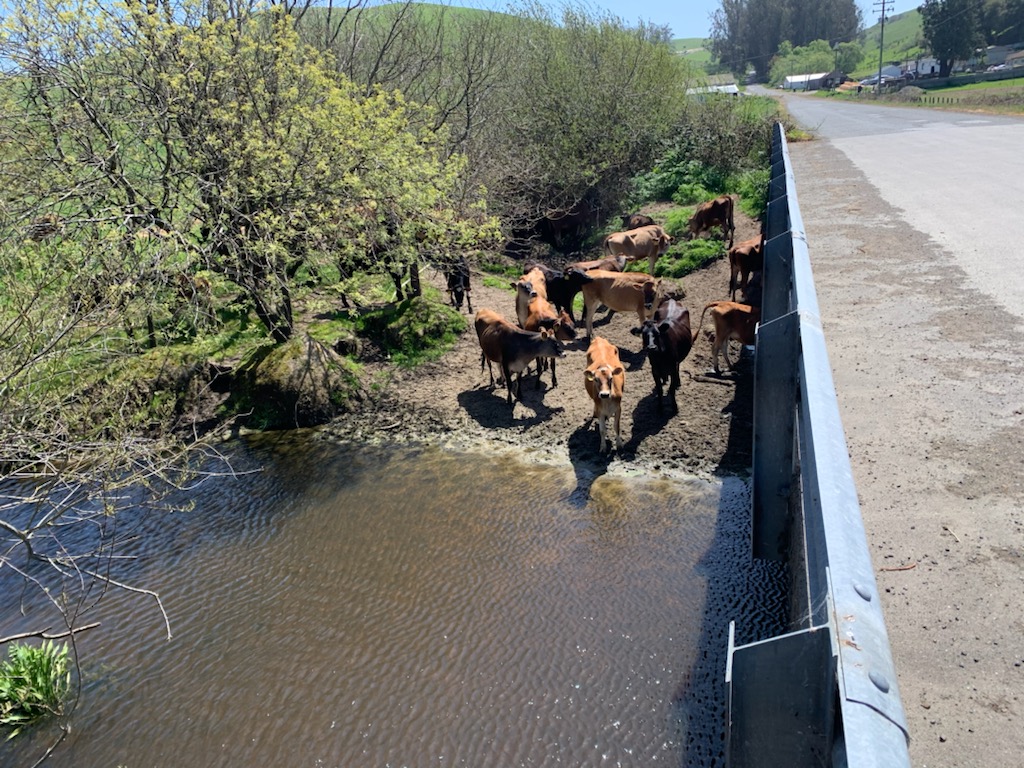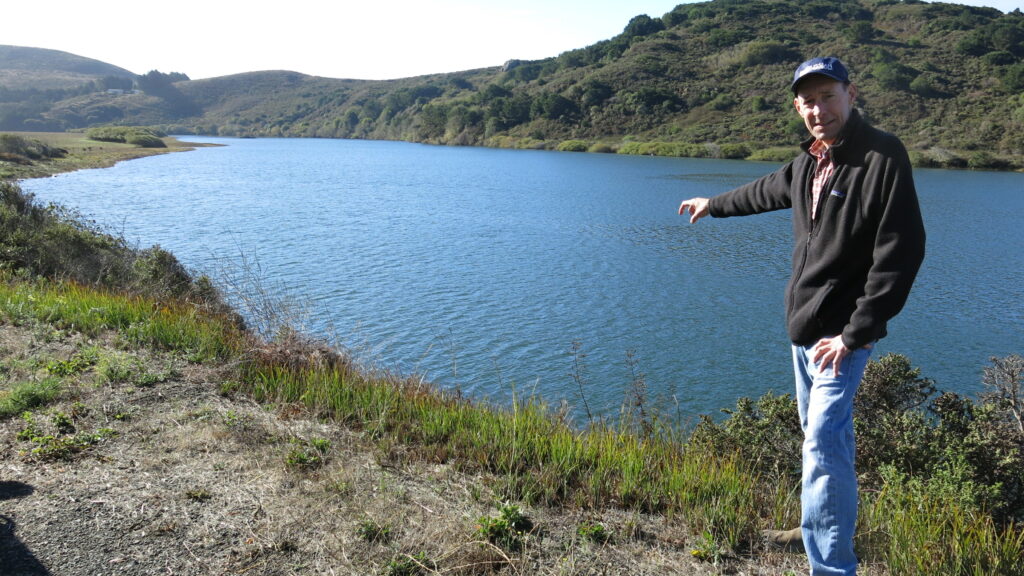
The water of a small stream in western Sonoma County flows slowly under a highway bridge, coursing its way through private ranchland to the ocean about seven miles away. Ducks paddle among floating vegetation, and an egret tiptoes slowly through the shallows. At the edge of the waterway, called Americano Creek, a cluster of cattle huddles under the willows. They frequent this spot and have trampled the banks to mud. Hoofprints can be seen leading into the water, and cakes of manure fester beside the stream, which meets the Pacific Ocean a few miles south of Bodega Bay.
“With the federal Clean Water Act, the state Clean Water Act, and all the other regulations, you would think this would be prohibited,” says Don McEnhill, executive director of the environmental watchdog group Russian Riverkeeper. The organization campaigns to protect Sonoma County salmon and steelhead habitat, which McEnhill says has been degraded by, among other things, cows in the water.
In fact, a suite of federal, state, and local laws ostensibly protect California’s watersheds from pollution, and volumes of codes are dedicated specifically to safeguarding streams and rivers from cattle. Yet through a variety of loopholes and exemptions, and possibly agency languor, roaming cows have access to many of the state’s waterways.
Here, the animals denude riverbanks, eliminate riparian habitat, and degrade water quality. High concentrations of manure-born bacteria are known to flow from Marin County cattle ranches into the waters surrounding Point Reyes. In the East Bay hills, cattle foul watershed habitat, trample creeks, and erode trails on public lands – damage that local groups have lobbied unsuccessfully to stop. Nitrates, an agricultural byproduct commonly derived from manure that can lead to health problems in humans, taint drinking water systems in the San Joaquin Valley, where feedlots are the suspected source of much of this contamination.
Alan Levine, the secretary of the Redwood Coast Watersheds Alliance, says the California regulators who deal with livestock and farm pollution have historically lagged on cracking down on violators. “It’s almost impossible to get agencies to enforce the law unless it’s a flagrant, publicly visible violation of the law that they just can’t ignore,” Levine says.
The North Coast Regional Water Quality Control Board’s permitting documents do not prohibit cattle entering waterways. But they state that “[g]razing in riparian areas shall be conducted in a manner that prevents, minimizes, and controls the discharge of waste to surface waters.” The same regulations address shoreline vegetation, requiring that “[r]iparian areas are managed in a manner that allows the natural establishment and growth of native vegetation … to prevent, minimize, and control surface erosion.”
But these impacts are almost the status quo for farms across the North Bay. A clear case of cows trampling and denuding a section of Americano Creek was reported to the North Coast Regional board on March 19. Though the board’s staff visited the site and corresponded with the farm owners, they took no immediate action to keep their cattle away from the water. In late September, the cows were seen standing in the shade of the creek bed, by then totally dry.

Currently, North Coast region dairy farms are under orders from water quality officials to submit Riparian Management Plans – checklist forms that describe how a farm will sustainably manage cattle near waterways. The rules governing cattle effluent and riparian impacts aren’t simple, even for activists familiar with this regulatory terrain. “It is very hard for us to tell what’s legal and what’s not,” McEnhill says. For instance, manure in the water does not necessarily constitute a violation — lab testing of the water is required to determine if water quality standards have been exceeded. Also, different rules apply to beef and dairy cows, and different rules apply to cows that are considered confined and those that are considered to be free-ranging. In the end, these somewhat arbitrary respective designations may determine whether cow dung in a creek is acceptable or not.
Laurie Taul, an environmental scientist with the San Francisco Bay Regional Water Quality Control Board, says her agency “loosely” manages cattle operations. She describes an overarching framework of rules that encourage but don’t require measures aimed at reducing environmental impacts of cows. “We encourage fencing [to keep them away from waterways], providing drinking water away from streams, riparian water management plans, healthy vegetation,” she says.
Levine says forcing regulators into action often requires citizen lawsuits. However, going to court over these matters didn’t help the Center for Biological Diversity and Alameda Creek Alliance. In the late 1990s, the groups sued the East Bay Regional Park District for allowing grazing on public land without first conducting environmental impact reviews. The suit, which the plaintiffs ultimately lost, alleged that “[l]ivestock grazing threatens sensitive and endangered species of plants and animals, increases erosion, and degrades water quality.”
“We submitted mountains of evidence and information and expert testimony that the court refused to consider,” recalls Jeff Miller, director of the Alameda Creek Alliance and a senior conservation advocate with the Center for Biological Diversity.

Another lengthy conflict has brewed at Point Reyes National Seashore, where environmental groups have challenged the use of parts of these federally protected public lands as, essentially, a vast farm. The cattle damage creek valleys and gulches and pollute marine zones that drain the peninsula’s hills. Point Reyes cows are also alleged by environmentalists to be the source of Johne’s disease, a bacterial infection that can kill ungulates and has been found in the local population of Tule elk. Protests and lawsuits against the National Park Service have failed to displace the cattle.
The organization McEnhill works with focuses its watchdog efforts on the Russian River, with an emphasis on rebuilding the shoreline and side-channel habitat so critical to the early life stages of Coho and Chinook salmon and steelhead trout, all of which have slid toward extinction in California’s coastal creeks and rivers. McEnhill says livestock in the watershed are not helping.
In the tidal reaches of the Russian River, near where it reaches the ocean, cows graze along the banks and can frequently be seen standing in the water, potentially damaging valuable habitat. “This is right where we’re putting so much effort into creating a nursery area for outmigrating salmon,” he says.
Levine, a former cattle rancher himself, says many farmers have neglected to put up cheap fencing to protect riparian zones because they know they can get away with it. That cattle denude streams in plain sight of public roads, and in spite of water-quality standards, tells Levine that agency staff are allowing it to happen. “It’s not being overlooked,” he says. “It’s being ignored.”
Top Photo: Cows in Americano Creek. Photo: Alastair Bland
LINKS
Dairy Program | California Northcoast Regional Water Quality Control Board